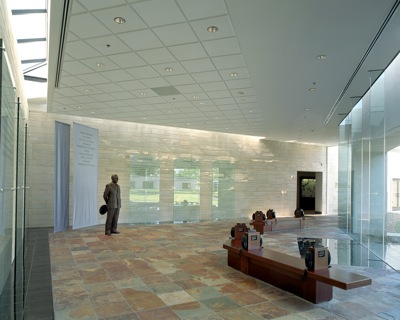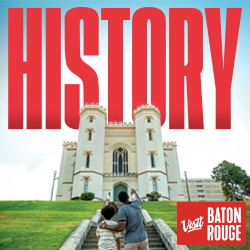 Courtesy Harry S. Truman Library and Museum
Courtesy Harry S. Truman Library and Museum
Harry S. Truman, the 33rd president of the United States, first entered politics in his hometown of Independence, Mo., as the elected Jackson County judge.
Dwight D. Eisenhower grew up in a two-story frame house in Abilene, Kan., where he learned the values that led him to West Point, World War II supreme Allied commander and the White House as the 34th president of the United States.
Bill Clinton launched his political career in Little Rock, Ark., as the state’s attorney general and then governor before being elected this country’s 42nd president in 1992.
All three men returned to their roots in locating their presidential libraries and museums in the towns where they got their starts. The Presidential Trail of Grand Central USA leads groups to these sites, three of the 13 presidential libraries administered by the National Archives and Records Administration.
Harry Truman
Like other presidents, Truman was actively involved in the development of his museum, which was built on a small hill in Independence overlooking the Kansas City skyline. However, Truman took it one step further and kept an office at the museum from the time of its dedication in 1957 until his death on Dec. 26, 1972.
Truman wrote letters, articles and books in the office; met dignitaries and presidents; and would even occasionally answer the phone for the museum. Visitors can see the office, which underwent a $1.6 million renovation and restoration in 2009, through a window in the courtyard.
The museum underwent a major $23 million renovation in 2001 that added glass windows to the building to allow more light to enter and added new interactive features and expanded facilities. Two floors of exhibits cover Truman’s life before and during his presidency, with artifacts, film clips, documents and memorabilia.
A replica of the Oval Office, the first in a presidential museum, has a voice-activated recording of Truman telling about the office. “This is an actual reproduction of my office in the White House,” he says. “The pictures you see on the walls and the things on my desk were things I had in the White House. I hope the museum gives you a better understanding of the presidency and the government of the United States.”
The lobby entrance features a large wall mural by Thomas Hart Benton that was painted on site by Benton over three years in the late 1950s and early 1960s.
Truman and his wife, Bess, are buried in the courtyard.
The white Victorian frame house in Independence where Truman and Bess lived for more than 50 years has been kept just as it was when he died, including his coat and hat on a rack next to the side door. However, the house is not practical for group tours and has a limit of eight people per tour.
Other sites in Independence associated with Truman are his restored office at the Independence Square Courthouse, the depot where he made the final stop in his successful 1948 whistle-stop campaign for president and the drug store where he held his first job as a teenager.
“It is still very much in operation,” said Janeen Aggen, media relations representative for the Independence Tourism Department “It has a wonderful old counter with stools, and you can have hand-dipped shakes right there in the first place he worked.”
www.trumanlibrary.org
Dwight Eisenhower
Eisenhower’s boyhood home is part of the Eisenhower Center complex in Abilene, Kan., that includes the presidential library and museum. The house is furnished as it was when Eisenhower’s mother, Ida, died in 1946.
The furnishings are original to the house, and the wallpaper in the two parlors, the dining room and the hallway are identical to the paper that covered the walls in 1946.
The Kansas limestone-faced Eisenhower Museum was dedicated in 1954 during Eisenhower’s first term as president and was enlarged and rededicated in 1971. The 30,000 square feet of exhibit space includes artifacts and items related to Eisenhower’s life and career in five galleries: an introductory gallery, a military gallery, a presidential gallery, a first lady’s gallery and a changing exhibits gallery.
The complex also includes the Place of Meditation, where Eisenhower; his wife, Mamie; and their firstborn son, David Doud, who died in 1921 at age 3, are buried. A visitors center on the site of Eisenhower’s first elementary school has a gift shop and an auditorium, where a brief film about Eisenhower is shown.
A bronze statue of Eisenhower in his familiar World War II jacket by sculptor Robert L. Dean Jr. is also on the grounds.
www.eisenhower.archives.gov
Bill Clinton
Located in the 30-acre Clinton Presidential Center and Park along the Arkansas River, the William J. Clinton Presidential Library and Museum has sparked a revitalization of Little Rock’s River Market District since it opened in November 2004.
The center also includes the Clinton Foundation and the University of Arkansas Clinton School of Public Service, which are located in a restored late-19th-century train station.
The five-story main building, which cantilevers over the river, has more than 20,000 square feet of exhibit space, most of which focuses on Clinton’s time as president, from 1993 to 2001.
Exhibits include one of the presidential limousines used during the Clinton administration; a timeline with eight 18-foot-long panels, one for each year of the Clinton presidency; and 14 alcoves off both sides of the timeline that focus on specific topics and events of the administration, such as the Oklahoma City bombing and the Middle East peace talks.
Click here to watch a video interview about Arkansas and Grand Central.
There are full-size replicas of the Oval Office and the Cabinet Room as they looked during the Clinton administration, along with a replica of a table from a White House state dinner.
The exhibits combine the latest technology with artifacts, photos and documents. In the Cabinet Room, for example, touch-screen computers provide information about Clinton’s Cabinet and about some issues faced by the Cabinet.
Clinton talks about his life and presidency in a 12-minute film in the Orientation Theater.
In addition to the state Capitol and the Governor’s Mansion in Little Rock, where Clinton worked and lived for more than 10 years while Arkansas governor, the Grand Central USA Presidential Trail takes groups to several other Clinton sites around the state, including his birthplace museum in Hope, sites around Hot Springs where he grew up, and the house where he and Hillary were married in Fayetteville while he taught at the University of Arkansas.
www.clintonlibrary.gov










